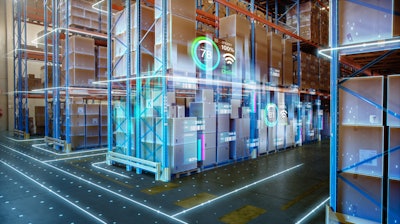
Indoor positioning technologies are one of the driving forces behind the digital transformation of the industrial sector. The ability to track objects, assets and people accurately and cheaply could save resources, time and money for companies in various sectors, from logistics to healthcare.
Xavier Vilajosana, a professor of computer science, multimedia and telecommunications and the leader of the Wireless Networks group at the Internet Interdisciplinary Institute (IN3) at the Universitat Oberta de Catalunya, is coordinating the university's participation in a new European project which is developing innovative solutions to improve location in indoor environments.
DUNE uses deep learning techniques combined with distributed computing systems, which take advantage of both cloud and edge computing. In other words, these are computing architectures that operate both on remote servers and near where the data are generated. The aim is to create a versatile system that uses the various technologies available and which can adapt to the different potential cases of use.
"There are numerous technological approaches today that attempt to exploit the characteristics of radio signals as a tool for obtaining the relative position between objects. This technological variety and the wide range of situations in which they can be used, with highly diverse budgets and environments for application, means that we need to develop a powerful framework for managing location data from different technologies in real time, which at the same time is able to adapt to multiple industrial needs and is economically appealing," said Vilajosana.
Assisted positioning using deep learning techniques
Indoor asset location uses the point of view of the receiving device to deduce which direction the signal emitted by the objects is coming from, and then translates this information into an estimate of its position. One of the main challenges for this technology is the wide margin of error arising from the obstacles between the transmitter and the receiver of the signal, especially in industrial environments, and multipath propagation. Multipath propagation is the phenomenon that leads to radio signals reaching the receiving antennas by two or more paths and at different times.
Signal processing is essential for this reason - otherwise ambiguities arise, leading to errors in the position of objects. Faced with this challenge, DUNE incorporates positioning mechanisms assisted by deep learning techniques at various stages of the location process in order to achieve optimal performance. Deep learning involves a type of machine learning algorithms which can be trained to learn from input, and that knowledge can then be used to draw conclusions based on new information.
"The data are processed using different approaches, such as deep learning methods which are trained to select the position estimates that best locate the objects being tracked," Vilajosana said.
Distributed computing strategy
The project will also take advantage of different computing architectures, from cloud to edge and far-edge computing. In other words, instead of a centralized strategy, the computation will be distributed in various nodes closer to the source of the data in order to reduce cloud computing processes, thereby decreasing the response time of the servers and the bandwidth, and simultaneously increasing the security of the data.
The system is entirely distributed, and composed of various sensor and location technologies placed on the objects to be located. These devices generate traces of raw data that have to be processed to obtain their estimated individual positions. An initial data processing takes place at the "far-edge," i.e. near the antennas that transmit the signals.
Data updated in real time
The radio signals from sensors attached to the objects or people to be tracked are received by the locator's array of antennas. These data have to be transformed to estimate the angles that define the direction of the signal and provide a real-time update.
"In a perfect world, this transformation is a geometric process that depends on the space between the antennas (distance) and the radio frequency (wavelength). However, these environments are subject to noise and irregularities," said Vilajosana. "When addressing these problems, deep learning methods can become a very valuable tool for obtaining accurate estimates of the position of objects."
Real-time data processing and aggregation take place using other "edge" devices to improve the system's performance. Another filtering step is added at this point to improve the signal translation and to be able to incorporate different technologies, using deep learning among other methods.
Infrastructure in the cloud
The estimated positions are delivered in real time from these edge devices to a cloud infrastructure, which is connected to the information systems of the factory or the logistics warehouse where the work is taking place. In the cloud, advanced artificial intelligence methods can be used for correction, improvement, classification, detecting anomalies and optimizing operations.
This cloud infrastructure handles the display and tracking of objects, and connects and interrelates this information with other subsystems such as those in the inventory of the factory or warehouse.
Large-scale test bench
This technological proposal will be evaluated throughout the project, which will last for 12 months in different scenarios, and its results will be compared with other current technological solutions. First, tests will be carried out in the research group's own laboratory and large-scale tests will subsequently be carried out in a building that has been purpose-designed for this type of experiment, which has an area of 1,000 m2 and which enables different technologies to be evaluated.






















